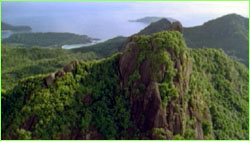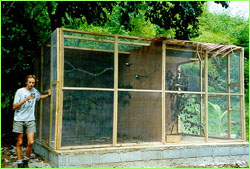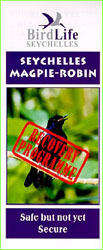 |
 |
|  Since
the mid-1990s, a multinational conservation team has strived to reintroduce
magpie robins to other Seychelles islands where they once thrived.
Since
the mid-1990s, a multinational conservation team has strived to reintroduce
magpie robins to other Seychelles islands where they once thrived.
|
Saving the Magpie Robin
Part 2 | back to Part 1
This early success gave the team the
confidence to try reintroducing the species to other islands where it formerly
lived. In 1994, they established a population on Cousin, a 70-acre island that
had become a nature reserve in 1968. Three decades of conservation work have
restored the plantation island to native forest, which teems with wildlife and
has proven to be a perfect home for the magpie robins. An initial group of nine
birds translocated in 1994 has grown to 27. In 1996, we also seeded a new
population on the island of Cousine, which is just south of and slightly
smaller than Cousin. Cousine is a private island managed for conservation, with
a small hotel specializing in ecotourism.
Interestingly, Cousin and Cousine have played key roles in an earlier, fruitful
pulling-back-from-the-brink. By 1959, the endemic Seychelles warbler had
dwindled to about 30 individuals. By 1987, following stringent conservation
measures, the population had soared to almost 400 birds, and three years later,
the International Union for the Conservation of Nature (IUCN) removed the
Seychelles warbler from its Red Data list of threatened species.
 Only a single magpie robin—a female—survived the most recent introduction to Aride, though with help
from BirdLife Seychelles, a male joined her there in early 2000.
Only a single magpie robin—a female—survived the most recent introduction to Aride, though with help
from BirdLife Seychelles, a male joined her there in early 2000.
|
|
The one
island that has eluded us is Aride. This mile-long scrap of granite has been
called the Seabird Citadel of the Indian Ocean. Ten species reside here,
including the sooty tern, the red-tailed tropicbird, and the world's largest
colony of the lesser noddy. Aride also once hosted a thriving population of
Seychelles magpie robins, which snatched up fish dropped by the seabirds.
Unfortunately, several reintroductions have failed since that first attempt in
the 1970s. We know that a major predator of Seychelles magpie robins there is
the barn owl, which, ironically enough, was introduced in the 1950s to control
rats, another robin killer. Poor habitat, pesticides, and bacterial infections
may also be to blame, but currently we're unable to finger the chief culprit or
culprits using the available data. Today only one pair resides on Aride, but
research is ongoing.
Looking up
Despite the failure on Aride, prospects for the Seychelles magpie robin are brighter
today than ever before. On January 1, 1998, BirdLife Seychelles, a newly formed
nongovernmental organization (NGO), assumed management of the Recovery Program.
We feel this is crucial for success, for while expatriate scientists provided
vital technical assistance in saving the species from immediate doom, only a
local NGO can achieve long-term sustainability. That is, local people can best
teach local people how to do things better.
|  Science coordinator James Millet
stands next to one of two recently built
aviaries on Frégate.
Science coordinator James Millet
stands next to one of two recently built
aviaries on Frégate.
|
In 1998, we also formed the
Seychelles Magpie Robin Recovery Team, or SMART. This group comprises BirdLife
Seychelles staff members, island owners and managers, and government officials,
who make decisions by consensus in conjunction with a technical advisory
committee based in the United Kingdom. We have also strengthened partnerships
with overseas institutions such as the New Zealand Department of Conservation
and the Zoological Society of London, which provide captive and health
management assistance, respectively.
We have strived as well to build awareness locally among
Seychellois. Most of the roughly 10,000 visitors to Cousin in 1999 had the
opportunity to see Seychelles magpie robins and learn of our conservation
efforts, for example, while tourists on Frégate can avail themselves of
weekly tours and lectures. Recently, six articles on the Seychelles magpie
robin appeared in the national newspaper The Nation, and a segment on
translocating the birds aired on television. We published a full-color brochure
and a newsletter, both of which we've distributed widely, and we put up a
display at our country's Natural History Museum.
Naturally, we have also
continued our efforts to protect the Seychelles magpie robin. When
translocating birds from one island to another, we previously relied on a
'hard' release method: capture and caging, transfer by helicopter, and release.
But when we realized that this could stress the birds, we began opting for a
'soft' version. This features captivity for two to three weeks before transfer
and a further week of captivity on the new island before release, which now
includes supplementary feeding.
 A BirdLife
Seychelles brochure proclaims the group's motto: "Safe But Not Yet
Secure."
A BirdLife
Seychelles brochure proclaims the group's motto: "Safe But Not Yet
Secure."
|
|
Two aviaries we built recently have
already more than paid for the time and effort we put into them. In November
1999, a young female with a broken bill turned up on Frégate. We placed
her in an aviary and fed her a combination of live prey and supplemental food.
She adapted well and soon had increased her weight by 15 percent. And in 2000,
we held the entire population of magpie robins on Frégate in the
aviaries for four months while we eradicated rats accidentally introduced there
in 1996 during tourist development.
Getting to safe
As I intimated earlier, however,
the Seychelles magpie robin is not out of the woods yet. Or should I say back
in the woods. Forest restoration must continue, and habitat loss is only
one of many threats still facing the species. Rats and cats can be accidentally
reintroduced; novel diseases like avian malaria, which decimated the birds of
Hawaii, can appear; and alien plants can quickly dominate the landscape,
disrupting the natural order of things. Inappropriate development,
unsympathetic managers, a downturn in tourism or international donor funding—all could potentially rend our fragile safety net.
With monies now on the way from the World Bank-funded Global Environment Facility, we hope to
establish populations of Seychelles magpie robins on several more predator-free
islands. Our goal is seven islands—including the current three and with four
of them self-sustaining—by 2006, with a total population of 200 birds. Only
then would we consider lopping off the last four words of our
motto.
 |
|
Dr. Nirmal Shah is chief executive of BirdLife Seychelles, an
NGO committed to safeguarding the Seychelles magpie robin. For more
information, contact BirdLife Seychelles at P.O. Box 1310, Victoria,
Mahé, Republic of Seychelles. |
Photos: (7-9) Courtesy of BirdLife Seychelles.
Seychelles Through Time |
Saving the Magpie Robin
Why Do Islands Breed Giants? |
Build an Island
Resources |
Transcript |
Site Map |
Garden of Eden Home
Editor's Picks |
Previous Sites |
Join Us/E-mail |
TV/Web Schedule
About NOVA |
Teachers |
Site Map |
Shop |
Jobs |
Search |
To print
PBS Online |
NOVA Online |
WGBH
© | Updated November 2000
|
|
|